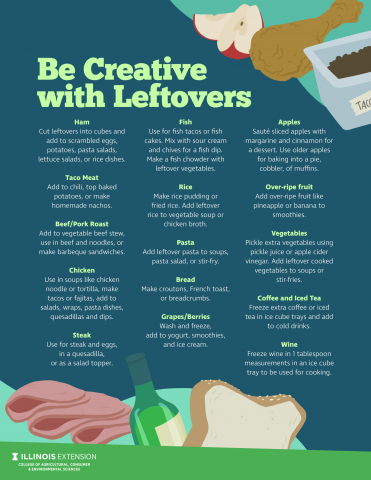Leftovers
Find Creative Ways to Use Leftovers.
Instead of tossing leftover food, save time and money by practicing these steps. Learn more about cooking with leftovers with our free tip sheet.
Store Cooked Leftovers in the Refrigerator and Eat Within 3-4 Days
-
Place leftovers in clear, airtight containers to easily see what is in them.
-
Label the item with the day the food is prepared. Use a removable label, or tape a sticky note to the container.
-
Move food that will spoil first to the front of the refrigerator, so that it will be a reminder to eat it soon.
Freeze Cooked Leftovers Within 3-4 Days
-
Place food in an airtight container made of plastic or glass. Remove as much air as possible before closing.
-
Label the container with the product name, the current date, and recommended storage time. In general, freeze casseroles for 2 to 4 months and soups and stews for 2 to 3 months.
-
Learn more @ What Can I Freeze?
Transform Leftovers Into a Completely Different Meal
- Find inventive ways to reuse and transform leftovers into new recipes to avoid eating the same thing night after night.
- Ask yourself if the food item can be turned into a stir-fry, soup, quesadilla, or casserole.
Practice Food Safety
Once food is cooked and ready to be stored, it is essential to refrigerate and freeze food properly. Leftover hot and cold foods should be refrigerated within 2 hours. Bacteria multiplies between the temperatures of 40°F and 140°F, known as the “temperature danger zone.” Place hot leftovers in shallow pans, no more than 4 inches deep, and refrigerate to allow for quick cooling.
Thawing
- Thaw using one of the four safe methods:
- Thaw in the refrigerator
- Thaw food in a leak-proof plastic bag immersed in cold water, and change the water every 30 minutes
- Thaw in the microwave and cook it immediately after
- Thaw during the cooking process, such as frozen hamburger patties on the grill
- Never thaw foods outside or in a garage, basement, or out on the kitchen counter. These methods can leave your foods unsafe to eat.
Reheating
If reheating in the microwave, use microwave-safe containers. Do not use plastic storage bags, brown paper bags, plastic grocery bags, newspapers, aluminum foil, or plastic containers. Reheat all food to 165 degrees° as measured with a food thermometer. Never reheat foods in a slow cooker; instead, reheat on the stovetop or microwave and transfer to a slow cooker to keep warm (140°F or above).
How to use leftovers
- Ham: Cut leftovers into cubes and add to scrambled eggs, potatoes, pasta salads, lettuce salads, or rice dishes.
- Taco Meat: Add to chili, top baked potatoes, or make homemade nachos.
- Beef/Pork Roast: Add to vegetable beef stew, use in beef and noodles, or make barbeque sandwiches.
- Chicken: Use in soups like chicken noodle or tortilla, make tacos or fajitas, add to salads, wraps, pasta dishes, quesadillas, and dips.
- Steak: Use for steak and eggs, in a quesadilla, or as a salad topper.
- Fish: Use for fish tacos or fish cakes. Mix with sour cream and chives for a fish dip. Make fish chowder with leftover vegetables.
- Rice: Make rice pudding or fried rice. Add leftover rice to vegetable soup or chicken broth.
- Pasta: Add leftover pasta to soups, pasta salad, or stir-fry.
- Bread: Make croutons, French toast, or breadcrumbs.
- Grapes/Berries: Wash and freeze, add to yogurt, smoothies, or ice cream.
- Apples: Sauté sliced apples with margarine and cinnamon for a dessert. Use older apples for baking into a pie, cobbler, of muffins.
- Over-ripe fruit: Add over-ripe fruit like pineapple or banana to smoothies.
- Vegetables: Pickle extra vegetables using pickle juice or apple cider vinegar. Add leftover cooked vegetables to soups or stir-fries.
- Coffee/Iced Tea: Freeze extra coffee or iced tea in ice cube trays and add to cold drinks.
- Wine: Freeze wine in 1 tablespoon measurements in an ice cube tray to be used for cooking.
